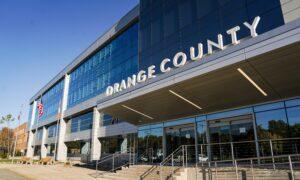A bipartisan group of six state lawmakers representing Orange County has joined a federal lawsuit to halt the New York City congestion toll that they say is unfair to their constituents.
“The congestion pricing uniquely hits Orange and Rockland counties west of the Hudson River,” Democratic state Sen. James Skoufis said during a press conference at Harriman train station on Feb. 1.
“They absolutely and certainly did not consider the unique inadequateness of the train service here,” he said, noting the bare minimum train schedules and lack of direct rides to New York City.
Per the congestion toll program, which is billed as the nation’s first, an average daytime commuter should expect to pay $15 extra per day for driving south of 60th Street in Manhattan.
For many Orange County commuters, that toll comes on top of the $15 or so they must pay to get past the George Washington Bridge.
A major argument for the congestion toll is that it will encourage more people to use public transportation and thus reduce traffic and improve air quality, but that logic is unrealistic and punitive for Orange County commuters, according to Republican state Assemblyman Rob Rolison.
“You are talking about individuals from this side of the river, who have got to drive in and who have got no choice, to pay that kind of money,” he said at the press conference. “For some of them, they got to work their first two hours just to make up what it cost for them to get in to work.”
As of Feb. 2, 31 parties have joined the same federal lawsuit as plaintiffs, including union representatives and lawmakers representing New Jersey, New York City, Long Island, and Orange County.
Originally filed by the United Federation of Teachers on Jan. 4, the federal lawsuit says that the proposed congestion toll program deserves a more comprehensive environmental review.
It asks the court to delay the toll program—which is scheduled to go into effect this spring—until such a review is completed by the Federal Highway Administration.
“My district is a mecca for New York City firefighters, police, and EMS [emergency management services] responders,” state Democratic Assemblyman Chris Euchus said at the press conference. “To tell them that they have to pay this new tax is ridiculous.”
For Democratic state Assemblywoman Aileen Gunther, the effect of the toll is personal.
“My son Jacob, a teacher down on the Lower East Side, travels each and every day to New York City for work,” she said. “This will be a financial burden on him—teachers don’t make a lot of money.”
Republican state Assemblymen Karl Brabenec and Brian Maher also joined the suit.
The Orange County state delegation demands either the county be exempted from the congestion toll—just as it was left out for the recent train fare hike and transportation mobility tax increase—or its residents be given a dollar-for-dollar credit to offset existing tolls, according to Mr. Skoufis.
The current congestion toll schedule allows $5 crossing credits only for car commuters entering the city through four tunnels: Queens-Midtown, Hugh L. Carey, Holland, and Lincoln.
Most vehicles enjoy a deep nighttime discount; certain low-income groups also qualify for lower rates.
A spokesperson for the Metropolitan Transportation Authority (MTA), which is responsible for designing and administering the congestion toll program, told The Epoch Times that Gov. Kathy Hochul and MTA Chairman Janno Lieber were determined to push the program through despite the legal challenges.
“We get sued every day, and I say get in line,” Ms. Hochul said at a Feb. 1 press conference at a New York City subway station. “[The congestion toll program] will happen.”
Both Ms. Hochul and Mr. Lieber said at the press conference that the congestion toll revenues, projected to be $1 billion every year, were a crucial funding source for the NYC public transportation system.
According to the MTA, 80 percent of toll proceeds will be used to improve NYC subways and buses, with the rest evenly split between Long Island and Metro-North Railroad.
The MTA told The Epoch Times in previous inquiries that it planned to use the toll revenue to fund two new passing sidings on the Port Jervis Line.
Members of the public can express their opinions on congestion toll rates to the MTA through an online form, email, mail, phone, or fax until March 11.
Public hearings are scheduled for Feb. 29, March 1, and March 4, after which the MTA board will vote on the congestion toll schedule.







